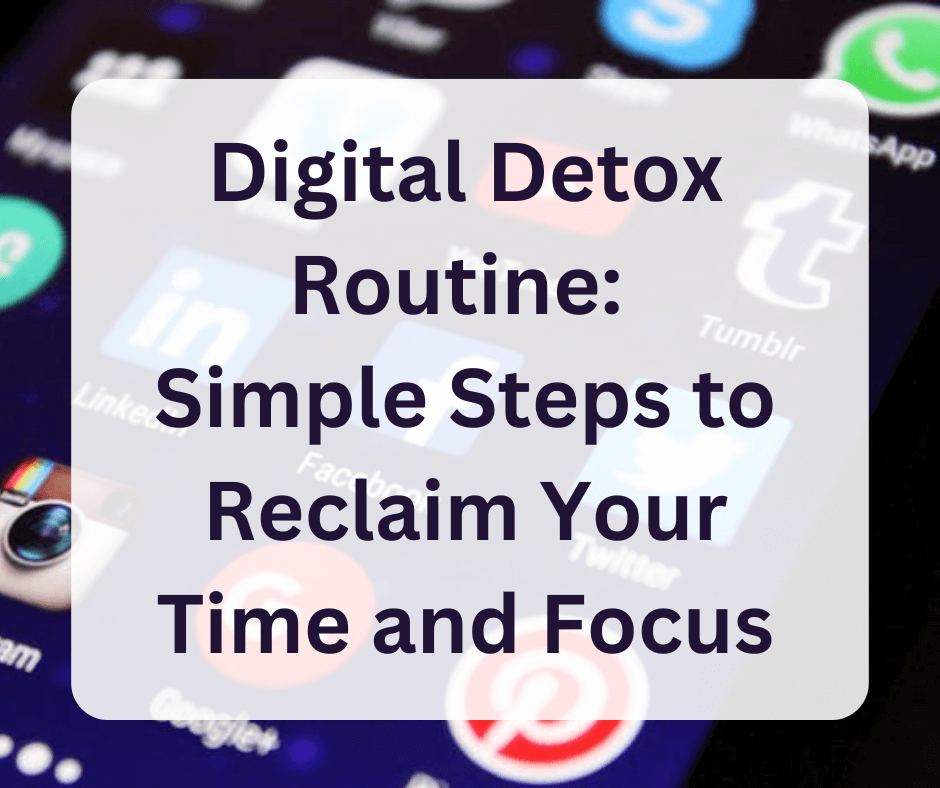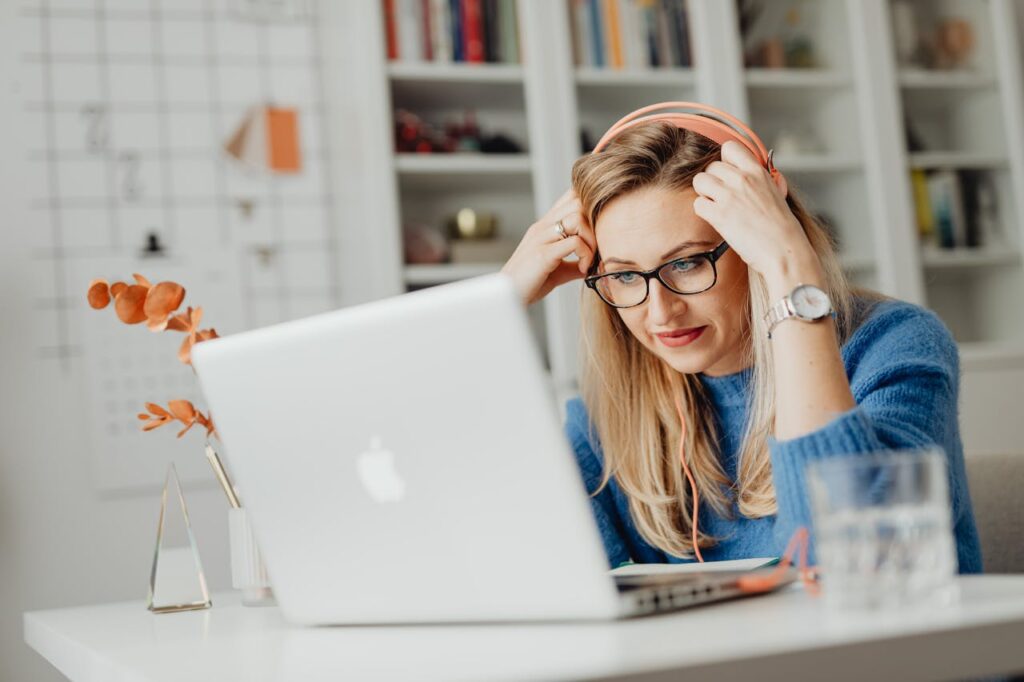The average person spends over 7 hours per day staring at screens. That’s nearly half our waking hours. Just think of everything we could achieve if we set up a digital detox routine and re-purposed all this time! We could learn new skills, spend more time with friends and loved ones, or have more time for our hobbies. So many new opportunities, if we just found a way to break free from this screen addiction!

In this comprehensive guide, we’ll explore how to create a sustainable digital wellness practice that doesn’t require completely disconnecting from technology. Whether you’re feeling overwhelmed by constant notifications or simply wanting to reclaim your time and attention, I’ll share practical strategies that actually work.
Understanding Digital Overwhelm
Digital fatigue is a phenomenon most of us are struggling with. Unfortunately, it’s such a normalised aspect of our life, that we don’t even notice it anymore. The constant use of screens has some physical effects, such as dry eyes, stiff neck or back pain. However, the psychological effects are even more worrying.
The expectation of constant connection can be mentally draining for a lot of people. You spend a lot of mental energy when you are always checking your social media or your phone, being constantly bombarded with information. This can lead to increased levels of stress and, after long periods, anxiety or depression.
Another unpleasant effect of constant digital exposure is having a dysregulated sleep cycle caused by the blue lights emitted by screens. Blue light imitates the kind of light we get from the sun, so it tells our brains that we should be awake. Exposure in the evening can make it more difficult for you to fall asleep. Inadequate sleep is also responsible for increased levels of stress and decreased productivity.

Last but not least, spending too much time online can be isolating. As great as social media is for connecting with people far away, it is no replacement for real relationships. We need real-life human connection to thrive. We need authentic and deep connections with other human beings. And that is difficult, if not straight-up impossible to achieve online.
This is why setting up a digital detox routine is a great idea for your overall well-being. Intentional technology breaks can can have visible and beneficial effects such as:
- improved social life
- improved sleep
- improved productivity
- less stress
Se let’s get into it and see how you can start setting up a digital detox routine.
The Foundation for Your Digital Detox Routine
First, you should conduct a personal tech audit. Identify any problematic technology usage patterns.
Track your app usage on your phone and identify the apps that take up the most of your time. Do the same for your laptop or tablet. If a social media app is used for more than 1 hour a day, that’s a problem app and you should consider limiting it.
Observe your behaviour throughout the day: are there moments when you tend to reach for your phone more often? Is it during work breaks? Is it before going to sleep? If helpful, use a journal to track your digital usage at different times of the day. Do this for a week, and you should be able to see patterns.
Based on these observations, you can begin to implement solutions to reduce screen usage.
- set limits for your most used apps, or uninstall them altogether
- de-activate push notifications from your social media apps
- unsubscribe from email lists that don’t provide useful information
- create a customised schedule for device-free times throughout your day. For example: no screentime 2 hours before bed, or not checking your phone when going out.
- establish dedicated tech-free zones in your home or workspace. For example: no phones in the bedroom. Make sure you base these rules on your previous observations of your behaviour: your goal is to change habits that don’t serve you.
Essential Digital Detox Practices
The 20-20-20 rule
Implement the 20-20-20 rule for reducing eye strain during computer work. For every 20 minutes of work, take a 20-seconf break and focus your eyes on something that is 20 feet away.
This works, because it takes about 20 seconds for your eyes to completely relax.
I know it’s difficult to keep track of time, especially when you are focused on your work, but you can set up a timer on your phone.
Batch processing emails and notifications
The constant influx of emails and notifications is quite energy-draining, when things are always beep-ing and ping-ing. You are in a constant state of activation, as you have to go back and check the newest message.
A great solution to that is learning to assign a specific – and limited – time for checking your emails and notifications. If you’re at work, check your email every hour.

Read and reply to all the emails, then go back to your work and don’t return until an hour later. And before you panic that you might be missing out, or that you might be ignoring an urgent message, let me tell you: nothing is that urgent. In 99% of the cases, the urgency is all in our head.
Do the same for the notifications on your phone. De-activate your push notifications for all social media apps. Trust me, it’s not the end of the world if you find out about your second cousin’s new profile picture 5 hours later. But your mental health and your attention span will thank you for it.
Create morning and evening routines that don’t involve screens
I know your first instinct in the morning is to reach out for your phone and check out what’s been happening while you were asleep. And because of our globalised and hectic world, there’s plenty to see. But try to resist it, and start off your day in a more mindful way instead.
Consider implementing new habits in the morning, that are more wholesome and can keep you away from your phone:
- meditation
- workout routine
- stretching exercises
- journaling
The same goes for your evening habits. You really don’t want to spend your evening on your phone, exposed to the blue light and constant negativity of news and social media drama. Find more constructive and relaxing activities instead:
- read a book
- unwind with your partner, talk about your day
- catch up with a good friend
- find screen-free hobbies
I know it feels scary to completely change your daily habits. I also know that FOMO is a real thing, and it takes a while to get over it. But it is possible, and you will get over it. You just have to be patient for a few days.
It’s amazing how quickly you get used to this new digital detox routine. And you will love the benefits, no matter how unimaginable it feels right now.
Mindful Technology Usage
No matter how unfortunate the effects of technology usage are, it’s unrealistic to think we can live without it. It’s part of our lives, whether we like it or not. We need to learn to live with it in a way that protects our well-being, while taking the best from what technology has to offer.
As mentioned in an earlier section of this article, it’s a great practice to set boundaries for your social media usage. Social media in itself is not bad. But because of its addictive nature, it’s easy to get carried away. Most social media apps allow you top set up a limit for yourself. Make sure you take advantage of that feature.
While at work, consider exploring productivity techniques that maximise focus, like the Pomodoro technique. The way this works is you do 25 minutes of focused work, without distractions. Then take a 5-minute break and repeat. This is a great method to train your attention, because 25 minutes really doesn’t sound that long, it is completely feasible.

I think it’s pretty obvious that your phone should be on silent while working. But consider using this function for other moments of your day when your focus is required. For example, when meeting a friend for dinner.
Not only is it rude to check your phone when you are talking to someone, but it also takes away from the experience. And at the end of the day, you are the one who is missing on a meaningful conversation and authentic connection.
Practise being more present in everything you do.
Maintaining Your Digital Detox Routine
And now that you have a digital detox routine, you need to make sure that you will stick to it. Otherwise, it’s just a failed experiment.
You do that by implementing the changes one by one. If you go from spending 7 hours a day on your screens to 1 hour, that’s going to be pretty drastic. You won’t enjoy it, and you will require an enormous amount of energy to stick to it. And energy is one thing we don’t have.
But if you only implement a new habit that is meant to reduce your screen time, this is easier. Of all the practices I’ve mentioned, pick one that seems the most feasible for you. Apply it for a week. Only then can you add another one to your daily routine.
Don’t be afraid to re-evaluate your routines and goals. The tips I shared in this article, are things that worked for me. But we are all different, and we have different circumstances. So maybe you need to teak one of these suggestions to fit your lifestyle.
Be flexible. Try out new things. Don’t be afraid to experiment. Be open, and always have your end goal in mind: a digital detox routine that supports your well-being and is easy to follow.
Conclusion
Ready to transform your relationship with technology? Remember, a successful digital detox routine isn’t about completely abandoning our devices – it’s about creating a healthier, more intentional relationship with them.
By implementing these strategies gradually and being patient with yourself, you’ll discover a more balanced approach to digital living. Why not start with just one small change today? Your future self will thank you for taking this important step toward digital wellness!

